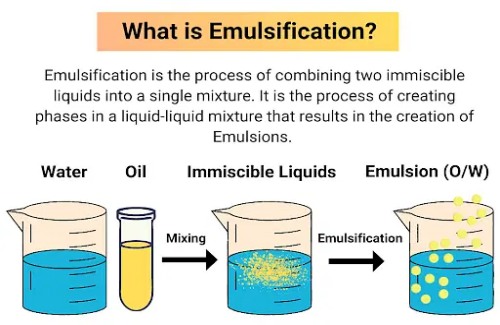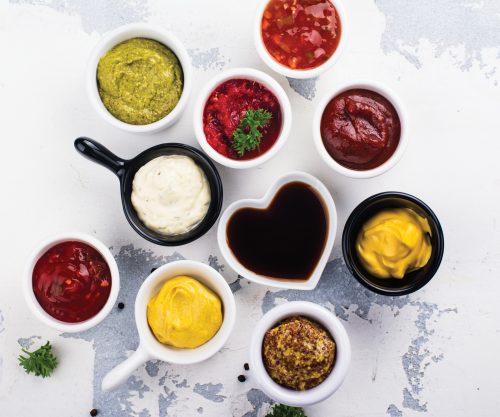Everything about the Function of an Emulsifier in Food and Its Value in Modern Cuisine
Emulsifiers are pivotal in contemporary cuisine, promoting the mix of immiscible liquids like oil and water. Their capacity to support combinations enhances the texture and taste of different foodstuff. From salad dressings to baked goods, emulsifiers play a significant function in both commercial and home food preparation. Yet, the scientific research behind their feature and the future advancements in their use stay less explored. Emulsifier In Food. What a lot more could be uncovered about these necessary culinary agents?
Understanding Emulsification: The Science Behind the Refine
Emulsification might appear like an easy culinary technique, it involves complicated clinical concepts that are vital for producing steady blends of immiscible liquids, such as oil and water. At the heart of this process lies the idea of surface tension, which avoids the two liquids from blending normally. Emulsifiers, materials that decrease surface area tension, play a vital function in assisting in the mix of these liquids. They have both hydrophilic (water-attracting) and hydrophobic (water-repelling) properties, enabling them to anchor themselves at the interface between oil and water.
When an emulsifier is presented and the blend is flustered, it develops a protective obstacle around spread beads of one fluid within the other, supporting the mix. This activity not just boosts appearance and mouthfeel in food yet additionally adds to their aesthetic allure. Emulsifier In Food. Comprehending the science behind emulsification is fundamental in contemporary food, permitting chefs to develop a range of sauces, dressings, and emulsified meals
Common Kinds Of Emulsifiers Utilized in Food
Emulsifiers are necessary ingredients in the food industry, playing a vital duty in stabilizing blends of oil and water. Different kinds of emulsifiers are commonly used, each with unique homes suited for different applications. Lecithin, derived from soybeans or egg yolks, is one of the most prominent natural emulsifiers, often found in dressings and delicious chocolates. Mono- and diglycerides, which are acquired from glycerol and fats, are extensively used in baked products and margarine to enhance appearance and prolong shelf life. An additional typical emulsifier is polysorbate 80, favored for its capability to enhance the uniformity of gelato and sauces. Additionally, xanthan gum tissue and guar gum work as thickening agents that also add to emulsification in gluten-free products. These emulsifiers are integral to developing a steady, palatable item in modern food formulas, making sure a pleasurable sensory experience for customers.
The Duty of Emulsifiers in Numerous Food Products
A variety of foodstuff count on emulsifiers to accomplish preferred structures and stability. These compounds facilitate the blending of immiscible liquids, such as oil and water, which is vital in many refined foods. For example, in salad dressings, emulsifiers help keep a constant mix, avoiding separation and boosting life span. In baked items, they add to an uniform crumb structure and wetness retention, improving total top quality.
Emulsifiers also play a considerable function in milk items, such as gelato and yogurt, where they support fat beads, ensuring a smooth mouthfeel. In addition, in sauces and dressings, they enhance thickness and boost spreadability. This capability is essential in the production of delicious chocolates, margarine, and mayo, where a natural product is essential. On the whole, making use of emulsifiers in various food products is indispensable to modern-day food manufacturing, improving security and uniformity throughout a large range of things.
Exactly How Emulsifiers Enhance Structure and Flavor

When integrated right into food, emulsifiers significantly boost both appearance and taste, developing a more pleasurable consuming experience. These materials assist in the mixing of ingredients that normally do not mix well, such as oil and water, leading to a smoother, creamier uniformity. This not only enhances mouthfeel however also allows flavors to spread uniformly throughout the product, amplifying the overall taste.

Emulsifiers in Home Cooking: Tips and Techniques
Just how can home cooks properly make use of emulsifiers to improve their recipes? Emulsifiers play a crucial function in attaining preferable textures and tastes in homemade dishes. For example, making use of egg yolks in mayo or index hollandaise sauce permits a secure solution, incorporating oil and water efficiently. Home cooks can likewise explore mustard, which acts as an emulsifier in vinaigrettes, ensuring browse around here a smooth uniformity.
In baking, incorporating lecithin, located in egg yolks or soy, can enhance dough stability and moisture retention. Additionally, utilizing industrial emulsifiers like xanthan gum tissue or guar gum tissue can help thicken sauces and dressings while keeping a luscious mouthfeel.
When producing ice lotions or whipped toppings, emulsifiers can stop ice crystal formation, causing a smoother texture. By understanding these techniques, home chefs can significantly boost their cooking developments, supplying consistent and enjoyable dishes that showcase the power of emulsification.
The Future of Emulsifiers in Culinary Innovation
As the culinary world remains to progress, the role of emulsifiers is poised to come to be significantly innovative and varied. Advancements in food science are resulting in the growth of new emulsifying representatives stemmed from all-natural sources, which deal with health-conscious consumers and improve the sensory high qualities of recipes. Advancements such as plant-based emulsifiers are getting traction, allowing cooks to produce vegan and allergen-free options without compromising structure or flavor.
In addition, the use of emulsifiers in molecular gastronomy is expanding, making it possible for cooks to experiment with unique structures and discussions that mesmerize diners. As sustainability becomes a top priority, the future might see a shift in the direction of eco-friendly emulsifiers that reduce ecological impact.
Inevitably, emulsifiers will proceed to play a crucial role in culinary advancement, linking the space in between practice and modernity, and enabling cooks to push the boundaries of creativity in their cooking areas.
Often Asked Questions

Are Emulsifiers Safe for Individuals With Allergic reactions?
Emulsifiers can be secure for people with allergies, depending upon their details level of sensitivities. Certain emulsifiers, acquired from allergenic sources like soy or eggs, might trigger reactions, demanding careful ingredient scrutiny and consultation with healthcare professionals.
How Do Emulsifiers Affect Food Rack Life?
Emulsifiers improve food shelf life by stabilizing combinations, stopping separation, and minimizing microbial development. This stability assists preserve texture and taste with time, enabling items to stay risk-free and enticing for usage much longer than without emulsifiers.
Can Emulsifiers Be Derived From All-natural Sources?
Yes, emulsifiers can be stemmed from all-natural sources such as plants, eggs, and dairy items (Emulsifier In Food). These natural emulsifiers help maintain blends, enhancing appearance and uniformity in various food applications while being preferred for health-conscious customers
What Are the Environmental Influences of Emulsifier Production?
The environmental impacts of emulsifier manufacturing consist of source depletion, environment damage, and pollution from artificial processes. All-natural emulsifier sourcing can minimize some results, yet in general, industrial practices still posture check out here substantial ecological challenges to ecosystems worldwide.

Exist Vegan Emulsifiers Available in the Market?
Yes, there are several vegan emulsifiers available in the marketplace, such as lecithin acquired from soy or sunflower, guar periodontal, and xanthan periodontal. These alternatives provide to plant-based diet plans without jeopardizing emulsifying properties.
Emulsifiers are crucial ingredients in the food market, playing an important role in stabilizing blends of oil and water. A range of food items rely on emulsifiers to attain desired appearances and security. When incorporated right into food products, emulsifiers substantially enhance both texture and taste, producing an even more delightful eating experience. In addition, emulsifiers can stabilize air pockets in whipped items like mousses and creams, leading to a light and airy texture. Emulsifiers improve food rack life by stabilizing combinations, preventing separation, and lowering microbial development.